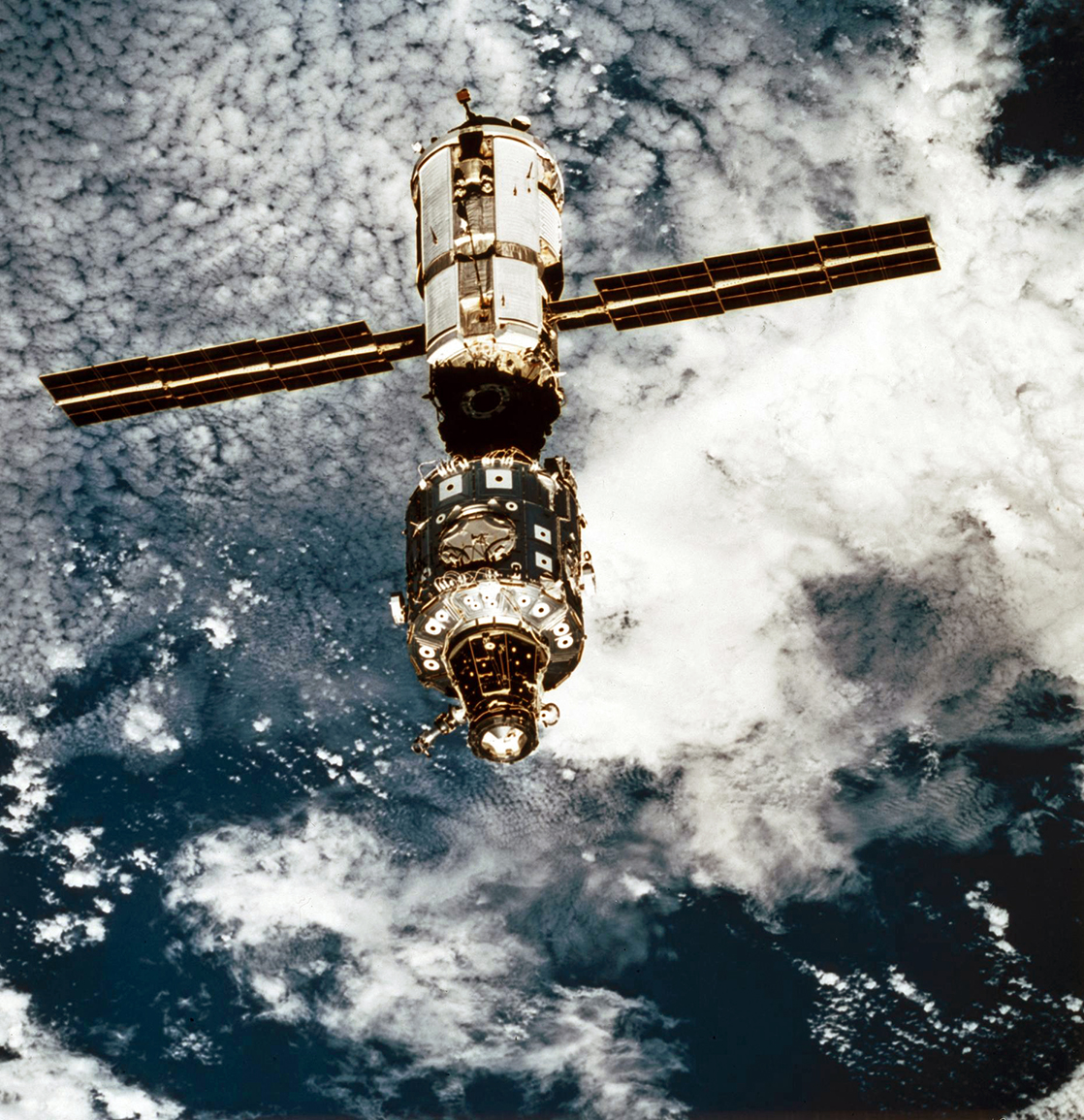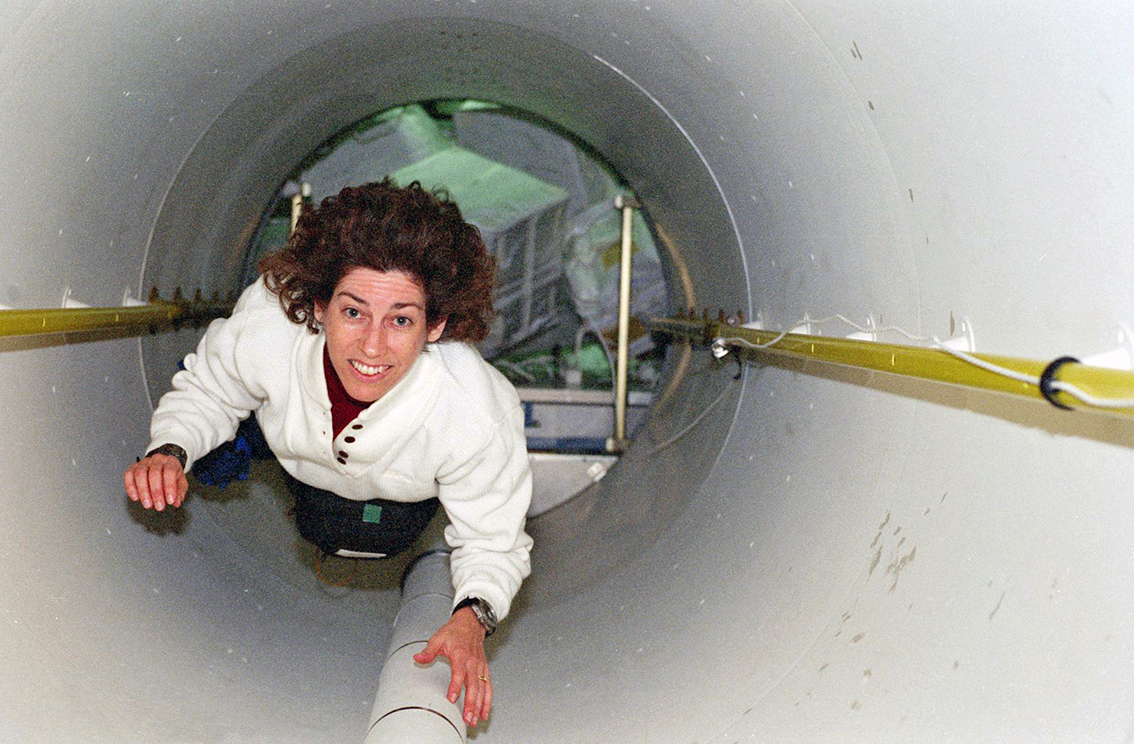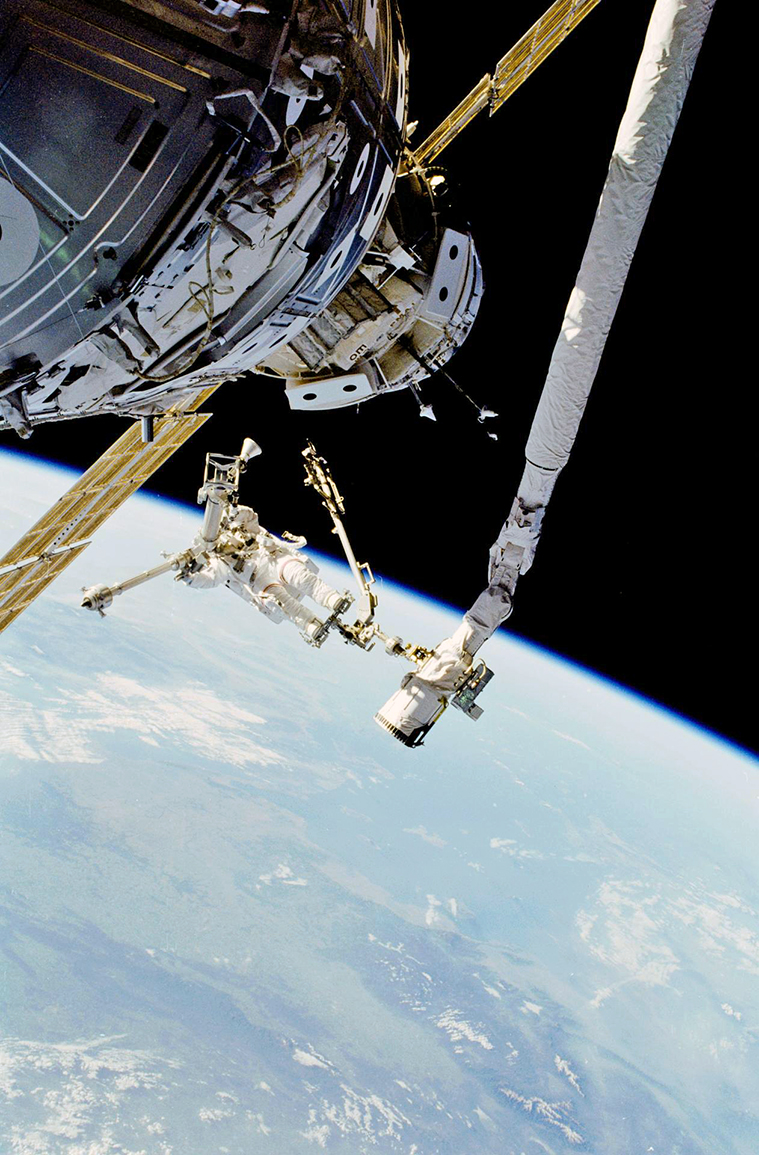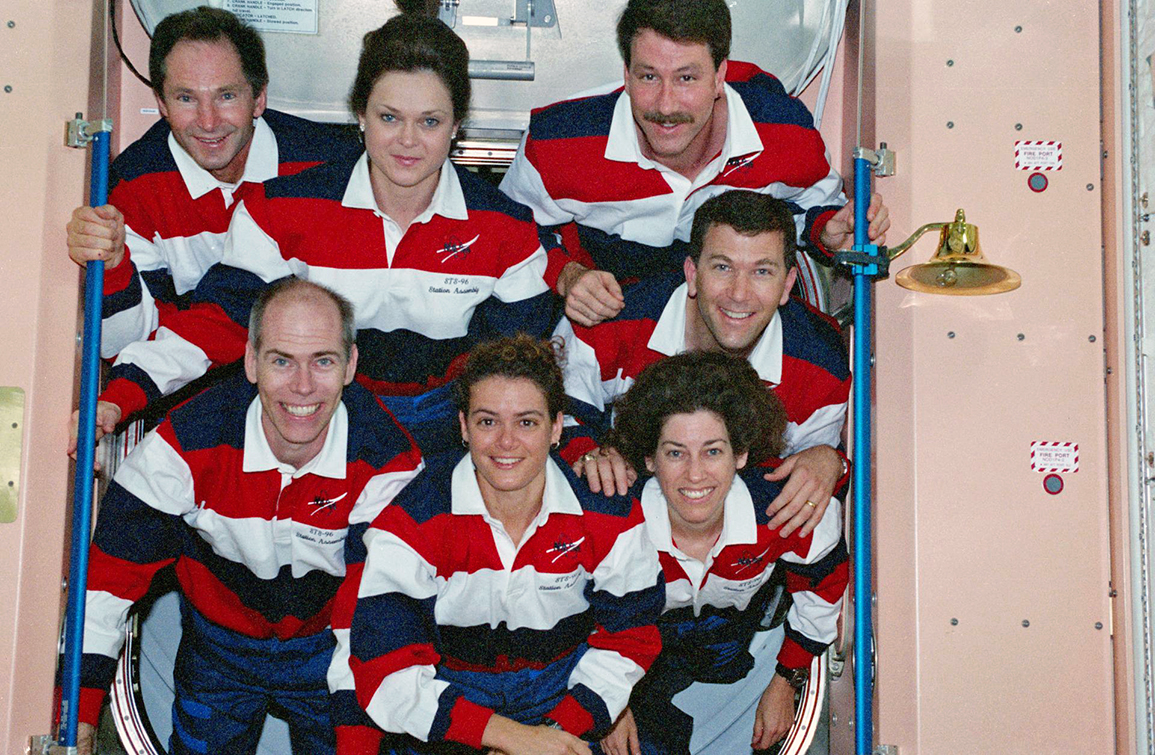Astro Info Service Limited
Information Research Publications Presentations
on the Human Exploration of Space
Established 1982
Incorporation 2003
Company No.4865911
E & OE
Expedition Zero Pt 3
Expedition Zero ISS Operations
Part Three - Testing and Troubleshooting
January 1999: A New Year and a New Problem
As the New Year dawned, the International Space Station (ISS) continued to orbit the Earth, slowly spinning at about one revolution per minute in the 'Stable Oritentation' atitude. However, by the second week of January, controllers had noted a gradual degradation in the voltage provided by the six batteries on Zarya over a period of several days.
Although the drop was only slightly greater than anticipated, it nevertheless prompted further action. As a precautionary measure, several non-critical heaters located in the Unity-to-Zarya adapter were turned off. Several smoke detectors were also automatically powered off briefly to reduce power consumption further. Other housekeeping procedures were instigated to improve the performance of the batteries, including the decision to deep cycle them every few days rather than once every two weeks as originally planned.
These actions increased the performance of the batteries to optimum levels while the problem was investigated further. It was believed to be a mechanical issue. All other systems aboard the station continued to operate normally, with no major system experiencing any interruption in power. It was decided that cycling each battery just once a week would be sufficient to maintain peak performance.
Controllers also tested the Kurs automated rendezvous system on 19 January, followed on 27 January by a test of Unity's Early Communications System (ECS) that had been installed by the STS-88 crew. The ECS was designed to send commands to some of Zarya's systems.
February - April 1999
Routine housekeeping, temperature control and power conservation measures continued on ISS as the station orbited the Earth awaiting its next visitor - STS-96. In February, most of the activities by flight controllers in Houston centred on a programme of tests using the ECS. The tests demonstrated the general command capability using NASA's communication satellites network - the Tracking and Data Relay Satellite System (TDRSS). This series of tests, lasting several weeks, also afforded the opportunity to train flight controllers in both the U.S. and Russia in contingency situations when command controlling was interrupted, through Russian ground stations.
The tests continued into March. Houston controllers first noted an apparent problem on 5 March with the starboard antenna, one of two exterior antennas mounted on Unity. As the station flew in certain orientations, a reduction of as much as 15% in the total capability of the ECS was noted. When this was discovered, the controller opted to turn off the starboard antenna and rely solely on the port one. As the system is a down-link (from station to ground), running on just one antenna was routine and had little effect on nominal day-to-day operations.
During the following week, the starboard antenna was periodically turned on to troubleshoot the problem. On 17 March, one of the Zarya exterior TV cameras was employed to try to determine the cause of the problem, but this proved ineffective. Troubleshooting allowed managers to determine that the antenna could still be used in its current condition with no risk of further damage. It was brought back online later that week. Without adequate TV pictures, theories as to the cause of the problem ranged from loose insulation to damage from orbital debris.
Early in March, it was decided to ship 18 small Charge-Discharge Integrated Current units from the Khrunichev Space Center in Moscow to the Kennedy Space Center (KSC) in Florida for integration into the payload manifest for STS-96. These units (Russian acronym, MIRT) were thought to be the cause of the reduced performance of the batteries aboard Zarya. No larger than a cellphone, these units were part of a system that indicated the level of charge in each battery, as well as recording when it registered that the battery was fully charged and was beginning to taper off its supply of power.
During the week of 15 March, controllers also successfully tested the Kurs-P automated rendezvous system that would be used during the docking of the Zvezda Service Module. Towards the end of the month, tests of the station's power system began in preparation for the arrival of STS-96. The three tests were to be completed prior to the launch of Shuttle Discovery the following month. Test 1 involved increasing power levels inside the Unity module while the station's environment (around 66°F or 18°C) was set up to match the conditions for when STS-96 arrived. This involved activating several heaters to determine the best method of warming the module prior to docking the Shuttle. It was found that the increase in power levels did not create any other operating issues. Test 1 was completed on 2 April and revealed that Zarya could deliver at least 900 watts of continuous power to Unity, which simplified operational planning for the upcoming Shuttle flight. As March ended, the station completed its 2,000th orbit since the launch of Zarya in November 1998.
The problem with the ECS pointed towards a suspected faulty transmitter box as the culprit. With a spare box already on ISS and other spares planned for delivery the next month, controllers decided not to fly another spare ECS antenna on the STS-96 mission, but they did add an inspection task for the Remote Manipulator System (RMS) prior to the already-planned spacewalk (Extra-Vehicular Activity, EVA) during the docked phase of the mission.
The next month saw the continuation of the power tests. Test 2 began on 14 April and involved sending commands from Mission Control Centre - Moscow (MCC-M) to the station to change its attitude from being perpendicular to Earth to being 'sideways-on', as it would be for the Shuttle docking. The test also required Zarya to deliver 1,500 watts of power to Unity while in this attitude. After the successful completion of Test 2, the station was returned to its original attitude that evening to continue power conservation and maintain even temperatures across the Zarya-Unity combination.
During the week of 20 April, an erroneous command was sent to ISS by the Russian flight control team. The command was issued from a ground station during a period when a direct link from MCC-M was not working. In order to send the command, the three-digit identification number was voice-linked to the ground station but was not received correctly, resulting in the incorrect command being uplinked to the station.
The intended command was supposed to enable the onboard computer to power up one of the solar arrays' retraction systems, without actually retracting the array. When the erroneous command was received on Zarya, the onboard computer failed to recognise it and sequenced an automatic disregard of the command, shutting off power to the motor. Fortunately, the sequence had no impact on any other ISS systems, with subsequent communications passes verifying that the motor had not run and the array did not move. The control team recycled the command and also set up a procedural review to ensure such occurrences did not happen in future.
Communication tests on the ECS continued through to the end of April. The third power test, Test 3, was completed by Russian flight controllers and concerned an update to the onboard software. This update was designed to permit only the use of the small thrusters on Zarya and prevent the larger 40-kg thrusters firing while the Shuttle was in close proximity or docked to the ISS.
On 23 April, STS-96 left the Vehicle Assembly Building (VAB) and rolled out to Pad 39B for final preparations towards its launch, which was targeted for 20 May. In Russia, the rollout of the Zvezda Service Module from the Khrunichev State Research and Production Company testing plant at the RSC Energiya Corporation was completed with the signing of the flight readiness certificate, marking the official hand over of the next ISS flight module to the launch processing team at the Baikonur Cosmodrome. It was planned to ship the module by rail to the Kazakhstan launch complex on 11 May, although the actual launch date had been postponed from July 1999 due to delays in completing the vehicle. A new launch date would be determined once the Zvezda reached Baikonur, where an assessment could be made of the testing that remained to be completed. It was beginning to look as though the Zvezda would not launch before the end of the year, seriously delaying the assembly sequence.
May 1999: Waiting for Discovery
As preparations continued for the STS-96 mission, Launch Complex 39 at the Cape experienced a hailstorm on 8 May, resulting in damage to the insulation on the Shuttle's External Tank (ET). A NASA Mission Management Team (MMT) evaluated the extent of the damage and its impact on the planned launch date.
On 12 May, ISS was commanded to turn to the docking attitude again and to remain there for 4.5 hours - three orbits - to allow the Zarya guidance system to be calibrated using the Earth's horizon as a reference point. After the test, the station returned to its Stable Orientation attitude perpendicular to Earth.
The following day, the MMT decided that the damage to the ET was extensive enough that it could not be repaired on the pad. The stack was rolled back to the VAB delaying the launch, which was rescheduled for 27 May.
In the meantime, ISS controllers had noted a false indication in one of the eight smoke detectors operating in Zarya. The faulty detector was powered off, as there was sufficient caution and warning capacity in the remaining seven units to monitor any potential onboard smoke hazards.
On 20 May 1999, ISS celebrated six months in orbit. That same day, Discovery was back on the pad to begin final preparations for its launch on 27 May on a mission to deliver over 1,600 kg (3,600 lbs) of hardware and supplies to ISS. Commands were issued to start the heaters aboard the station on 24 May. This was done to bring temperatures up to a comfortable level in time for when the crew opened the hatches to begin work inside the station. ISS was once again re-orientated to the docking attitude to await the arrival of Discovery.
STS-96 was launched successfully at 06:49 Eastern Daylight Time (EDT) on 27 May, to begin the first phase of logistics re-supply to ISS prior to the launch of the Zvezda module. Docking with the Unity module occurred at 23:44 Central Daylight Time (CDT) on 28 May. ISS was about to receive visitors for the second time.
Crew of STS-96
Kent V. Rominger, NASA, CDR, 4th flight
Richard D. 'Rick' Husband, NASA, PLT, 1st flight
Daniel T. 'Dan' Barry, NASA, MS-1, 2nd flight
Ellen L. Ochoa, NASA, MS-2/FE, 3rd flight
Tamara E. 'Tammy' Jernigan, NASA, MS-3, 5th flight
Julie Payette, Canadian Space Agency (CSA), MS-4, 1st flight
Valery I. Tokarev, Roscosmos, MS-5, 1st flight.

This image of ISS (taken on the fly-around after the departure of STS-96) shows the newly installed Strela crane on the Zarya module, part of the logistics and equipment carried by the STS-96 mission. The early part of the year had seen numerous tests and evaluations carried out on the fledgling station prior to the Shuttle's arrival.
MS Ellen Ochoa floats through the tunnel connecting STS-96 to the ISS. The crew transferred over 1,600 kg of supplies to the station during the mission, some of which can be seen behind Ochoa in this image.
Perched on the RMS arm over 300 km above the Agean Sea, MS Tammy Jernigan handles part of the crane that she and fellow EVA astronaut Dan Barry would install on the ISS during STS-96. The pair also added toolbags, handrails and foot restraints to the outside of the station.
The crew of STS-96, the first Shuttle re-supply mission and the first to dock with the station. (Clockwise from top left) MS Valery Tokarev, MS Tammy Jernigan, CDR Kent Rominger, PLT Rick Husband, MS Ellen Ochoa, MS Julie Payette and MS Dan Barry.






